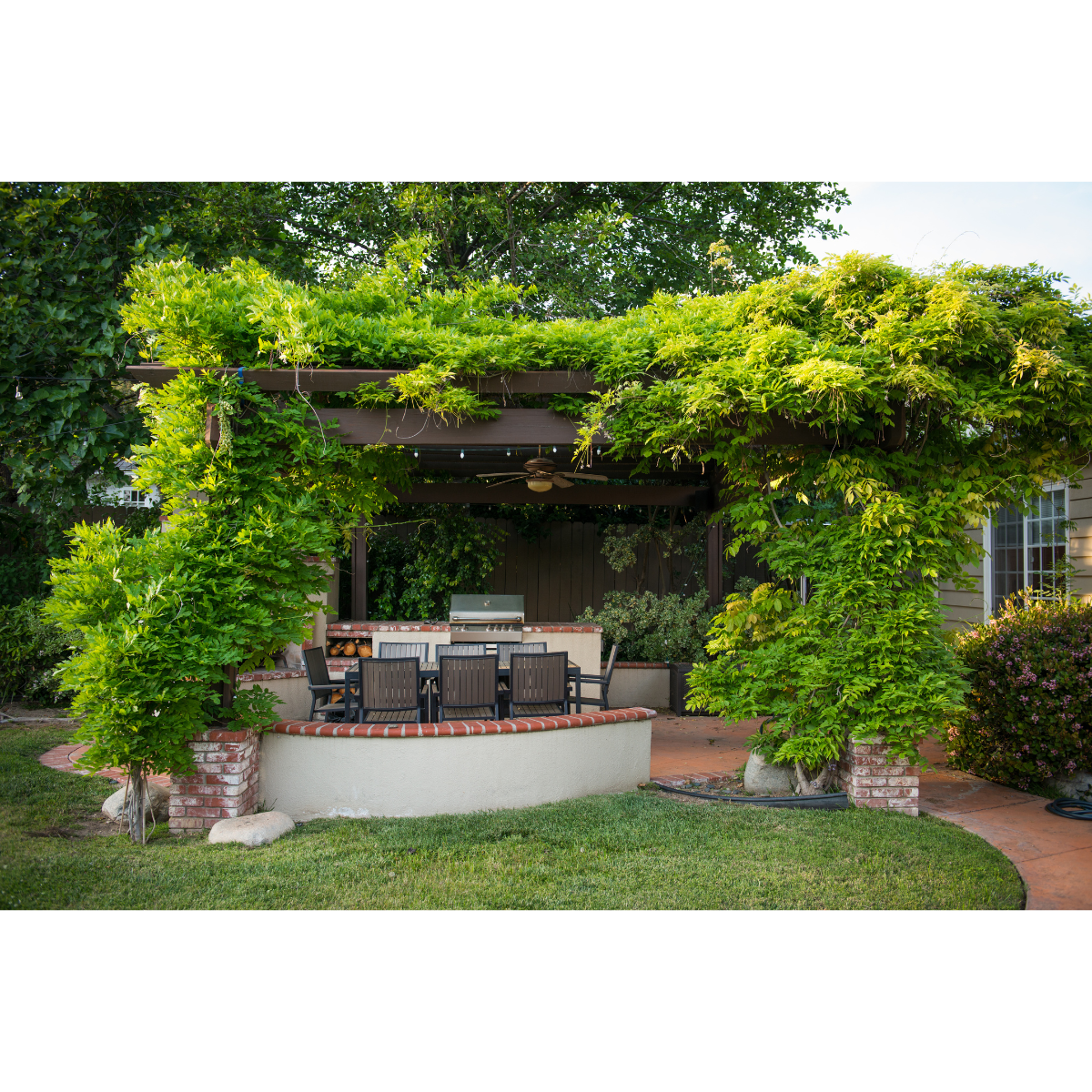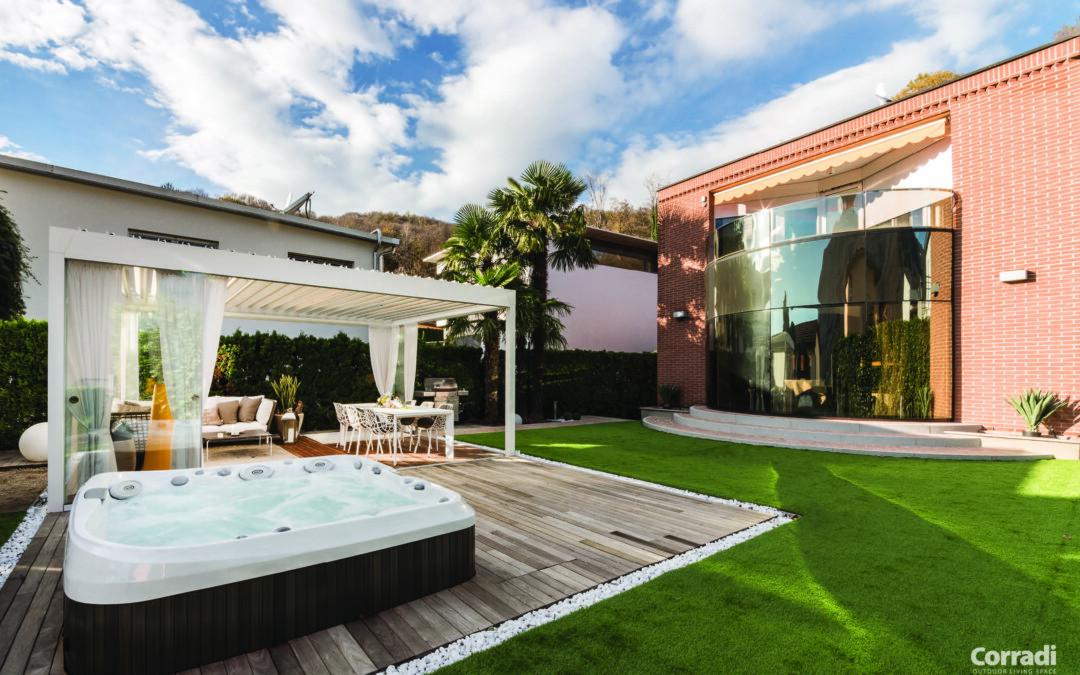You’ve been dreaming about this veranda! But now that it’s yours, all that’s left to do is fit it out. Easier said than done…
A veranda, yes, but what for?
In most homes, the veranda serves as a dining room or living room. While it fully fulfils its mission in this type of case, it does not stop there! There’s nothing to stop it housing a kitchen, library, playroom, conservatory or, if fitted with blinds, a bedroom or bathroom. Every part has its place. You just have to think it through intelligently beforehand.
1. It’s all about harmony!
Whatever the purpose of the room, particular attention must be paid to consistency! In most cases, the veranda is an extension to the existing house. It was not designed at the same time as the house itself, nor was it built using the same materials. To integrate it properly, it is necessary to maintain a certain harmony. Details are everything.
The color of the frames can be a way of combining the two constructions. If you’ve opted for blue for your home, it’s advisable to keep the same shade for the veranda. On the other hand, if you’ve decided on gray for your home, opt for a brighter color for the extension.
If you prefer clean lines and light colors, you should be able to furnish your annexe without too much fuss. Spotlights add warmth and light to the room.
While tiles are often chosen to dress this type of room, parquet flooring can also be considered, as long as it doesn’t clash with the flooring of adjoining rooms. The same goes for the color of the walls.
2. Furniture level…
A veranda is a room that opens onto the outside world, thanks to its large bay windows, so designing it can be a real headache! It’s out of the question, of course, to place a tall piece of furniture right in front of a window. The veranda would no longer be of any interest. It is therefore necessary to use low-level furniture in these areas, so as to retain all the available light.

3. Create a green space
Without turning your annex into a tropical garden, the veranda is the ideal place to store your orchids and other light-demanding plants. This makes it easy to install a small green space.

4. Playing with curtains and blinds
Curtains and blinds can play an essential role in the design of your conservatory. They let you control the room’s brightness and privacy. Opt for light, sheer curtains that let in natural light while adding a touch of softness to your space. Blinds, on the other hand, allow you to filter light and protect you from the sun’s direct rays on the hottest days. Make sure you choose UV-resistant materials to preserve the durability of your curtains and blinds.
5. Create functional zones
For a well-designed veranda, it’s important to define distinct functional zones. For example, you can create a sitting area with a comfortable sofa, a coffee table and a few armchairs for relaxing and entertaining guests. Another area can be dedicated to the dining room, with an adapted table and chairs. If you have enough space, you can even consider setting up a small work area with a desk and an ergonomic chair. The aim is to maximize the use of your veranda by creating spaces dedicated to different activities.
6. Think lighting
Lighting plays a crucial role in the ambience of your veranda, especially when night falls. Choose warm, subdued lighting to create a pleasant, relaxing atmosphere. You can use floor lamps, wall sconces or even string lights to add a touch of elegance to your veranda. Don’t forget to provide nearby switches for easy access to lighting.

7. Integrate decorative elements
Decorative elements are essential to give character to your veranda. Add houseplants for a touch of greenery and freshness. Cushions and plaids can be used to create a cosy, welcoming atmosphere. Don’t hesitate to hang pictures or mirrors on the walls to add depth and personality to your space. Accessories such as vases, scented candles and sculptures can also add a touch of style to your veranda.

8. Choose appropriate materials
When choosing furniture and materials for your conservatory, make sure they are suitable for an environment exposed to temperature variations and humidity. Choose weather-resistant furniture in woven resin, teak or aluminum. Cushion and curtain fabrics must be treated to resist UV rays and humidity. By choosing durable and appropriate materials, you can ensure that your veranda will remain beautiful and functional.

9. Enjoy the benefits of the natural environment
A veranda offers a magnificent view of your garden or the surrounding countryside. Enhance these natural assets by positioning your furniture to take full advantage of the view. Direct your seating towards points of interest, such as a majestic tree or a colorful flower. You can also create a vertical garden outside your veranda by installing hanging pots or planters on the walls. This will add a natural, soothing dimension to your living space.
10. Don’t neglect thermal comfort
To make the most of your veranda all year round, make sure you maintain optimum thermal comfort. During the colder months, consider installing a supplementary heating system, such as an electric radiator or wood-burning stove, to create a cosy atmosphere. During the summer months, think about ventilation by installing ceiling fans or fans to cool the atmosphere. In addition, the use of blinds or solar films on glazing can help regulate temperature by blocking some of the sun’s rays.
Conclusion
By following these ideas and tips, you’ll be able to design your veranda in a harmonious and functional way, creating a pleasant and welcoming living space. Don’t forget to let your creativity flow and personalize your veranda to suit your tastes and needs. Take advantage of this new space to relax, entertain loved ones and reconnect with the natural world around you.
Don’t hesitate to contact us if you need any further help with your veranda. Our team is here to advise and support you in the realization of your project.




